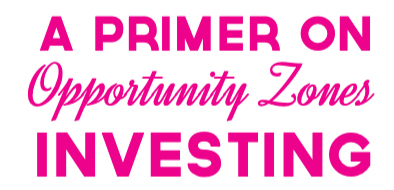

The opportunity zone program was enacted as part of the 2017 Tax Reform with the goal of directing long-term capital investments into underserved rural and urban communities. This program is viewed by many as the most ambitious federal tax incentive program for taxable investors to invest in real estate in decades. With an estimated $6.1 trillion of unrealized capital gains, the program uses a free-market approach to create economic resurgence and job creation in the low income and blighted communities.
Qualified opportunity zones are “economically distressed communities where new investments may be eligible for preferential tax treatment.” To qualify as an opportunity zone, a locality had to be nominated for the designation by its state governor and certified by Treasury. Treasury certified 8,764 census tracks in the 50 states, District of Columbia, and five possessions, including the entire island of Puerto Rico.
Taxpayers may receive tax incentives by investing their capital gain into opportunity zone property. Investments, however, cannot be made directly by a taxpayer. Within 180 days of the date of sale or exchange, investors must invest the capital gains into a qualified opportunity funds (QOF). A QOF is an investment vehicle that can be a corporation or partnership. Ninety percent of the assets in a QOF must be invested in businesses or property locate within an opportunity zone throughout the fund’s life.
Background on the tax incentives
The opportunity zone program provides the most incentives to long-term investors. First, investors in QOFs get a deferment on paying taxes on the original capital gain investment until December 31, 2026 or until the interest in the opportunity fund is sold, whichever comes earlier. Second, the capital gains investment has a zero basis. Investors get a 10 percent basis step-up after five years and a 15 percent basis step-up after seven years. Lastly, after 10 years, the appreciation of the investment in the fund is tax-exempt.
Clearly, the benefits for appreciated property relating to the 10-year hold is the largest benefit and the incentive receiving the most attention. It is important to note that a taxpayer will always pay tax on at least 85 percent of the original capital gains. Further, the tax rates at December 31, 2026 or the date of sale will determine the tax due. Currently, the tax rate is 23.8 percent on capital gains – the tax rate in ten years may be significantly different. Further, the tax attributes will remain, as such the short-term and long-term treatment will carry over.

Where to invest?
Few tax incentives and investment opportunities have brought about as much excitement and media attention. The guidance released by Treasury and the IRS favors real estate investments with the “substantially all” and 50 percent of gross income requirements. Investment in the typical large gateway markets in areas where revitalization has already started is getting a lot of the early investments. However, other non-gateway cities such as Philadelphia, Baltimore, Portland, and Nashville are receiving a lot of attention.
There are prime properties in the downtown areas of many of these cities that aren’t available in the traditional markets. Further, many successful cities have put in place a program to streamline the permit and zoning process. And, many states are offering credits and grants to encourage investments. In these cases, investors can stack the benefits and reap both federal and state incentives.
The opportunity zones are in distressed areas so there is inherent risk. Due diligence on the part of the investor is key. In addition to the location, investors should review median household income of the area, vacancy rates, unemployment rates, infrastructure, reputation of the developer, and track record of the developer to determine if the real estate project is a good investment. It is important to remember, however, that while this program offers potentially large tax benefits, it will not turn a bad project into a good project. But, opportunity zones could make a good investment a great investment.
Impact Investing
The enactment of the opportunity zone program offers vehicle for high net worth individuals and institutions to diversify their funds in a meaningful way. The goal is to create jobs that result in higher wages. This should result in better government services for the community, including better schools and infrastructure.
While there has been some skepticism about the program, EIG’s recent comprehensive analysis of the opportunity zones suggests that more than 96 percent of the designated zones do not show signs of gentrification. Further, some of these zones have been recently hit by natural disasters. For example, the entire island of Puerto Rico is an opportunity zone. As such, the opportunity zones could fill a large need by using private funding to revitalize these devastated communities
What’s Next?
To maximize the tax benefits, taxpayers must invest in the QOF before December 31, 2019. The lack of guidance from Treasury and the IRS has many investors sitting on the sidelines. A hearing was held on February 14th to listen to the comments from the public and investors should be receiving additional guidance in the upcoming weeks. Additional clarity is needed for the opportunity zone program to achieve its maximum impact.
We may not know for a decade or more whether the program was successful, but investment in these underserved communities is the first step for the program to achieve its goals.


 Login
Login
